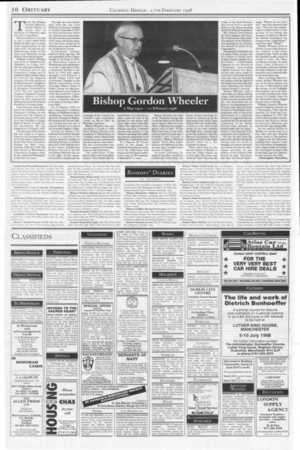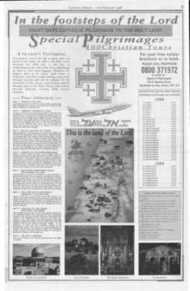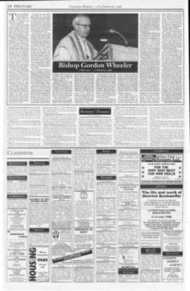Page 10, 27th February 1998
Page 10

Report an error
Noticed an error on this page?If you've noticed an error in this article please click here to report it.
Tags
Share
Related articles
Bishop Wheeler Dies
Bishop Leads Tributes To Wheeler
Salvador Aid
Bishop Wheeler Has Heart Attack
Enterprise Of Bishop Wheeler
Bishop Gordon Wheeler
5 May 1910 21 February 1998
TILE RI. REV William Gordon Wheeler,
former Bishop of Leeds, died on Saturday, 21 February, aged 88, after a long illness.
His last wish was to be laid to rest a stone's throw from Bishop Poskitt, also a convert from Anglicanism, in the crypt of the 150-year-old, neo Romanesque church of Clifford, near Wetlierby, in the diocese they had governed, William Gordon Wheeler was born in Saddleworth, Yorkshire, on 5 May, 1910.
He was educated at Manchester Grammar School and University College and Sr
Stephen's Hall, 0,dbrcl, where he read for the Anglican
ministry. He held curacies at St Bartholomew's, Brighton, in 1933 and then at St Mary's
& All Saints, Chesterfield, in
1934. He was appointed Assistant Chaplain to Lancing College, Sussex, in 1935, where he first acquired his lifelong interest in the spiritual formation of young people.
Later that year, much influenced by reading Cardinal Newman's writings, he was received into the Church at Downside and, in 1936, went on to the Pontificio Collegio Beda in Rome to study for the priesthood. He was ordained on 31 March, 1940.
The first part of his priestly life was spent in London, where he was Assistant Priest at St Edmund's, Edmonton, in the East End of London, during the Blitz years, between 1940 and 1944. He then moved to Westminster Cathedral as Chaplain, where he also edited the Westminster Cathedral Chronicle. Through his close friendship with the late Lord Furness, he became Chaplain to London University in 1950: he often told the story of how the appointment had arisen. He had run into Lord Furness in the street, and all the essentials had been settled in 40 minutes over a cup of coffee at the Archbishop's house.
Ecclesiastical honours followed thick and fast. He was appointed a Privy Chamberlain to the Pope in 1952, an Honourary Canon of Westminster and Administrator of the Cathedral in 1954, a Domestic Prelate to the Pope in 1955 and (again through Lord Furness) a Bailiff Grand Cross and Conventual Chaplain to the British Association of the Sovereign Military Order of Malta (whom he affectionately referred to as in NIA's) in 1956. He served for 11 years as the Administrator of Westminster Cathedral, where he took pride in tiearing confessions daily.
On 19 March, 1964, he was consecrated Coadjutor Bishop of Middlesborough by Archbishop Cardinale, then Apostolic Delegate in Britain. He attended the Second Vatican Council and was one of only two bishops not to stay at the Venerable English College.
Instead, he stayed at the I3eda and Archbishop Roberts stayed at a convent in the opposite direction, leading an ecclesiastical wag to comment that most of the bishops were in the centre, Archbishop Roberts was out to the left and Bishop Wheeler was out to the right. On his return, determined to implement the
teachings of the Council, he founded a new ecumenical centre at Wood Hall in Wetherby, Yorkshire.
Bishop Wheeler, who was appointed to Leeds in 1966 when Bishop Heenan was translated to Westminster as Cardinal, wasn't afraid of his reputation as an ecclesiastical and theological conservative. But his conservatism was always tempered by humility, humour and experience.
The publication of the Pope's birth-control encyclical Humane Vitae shortly after his appointment to Leeds did not cause a pastoral crisis in his diocese: he was always willing to talk to those with difficulties. His approach to this delicate question combined unswerving loyalty to the Church's teaching with unfailing pastoral gentleness in its application to individual cases.
In a famous Ad Clerum letter to his clergy, he reminded them that he understood the difficulties well because he had heard confessions daily in Westminster Cathedral for 11 years.
Bishop Wheeler was fond of the Tridentine liturgy and would say Mass in the old rite upon request. After one such Mass, a lady from the congregation said to him: "If the Mass had been as old fashioned as that four years ago, I wouldn't have become a Catholic." Bishop Wheeler replied: "If the Mass hadn't been as old-fashioned as that 40 years ago, I wouldn't have become a Catholic."
At Leeds Cathedral, he insisted that Mass should be celebrated beautifully. On
Easter Sunday morning, he would be dressed up in the long purple train of his Cappa Magna with two small altarservers in tow, and would sweep up the nave towards the High Altar, turning right at the last moment to visit the Blessed Sacrament Chapel and kneel in front of the Pugin reredos there for a few moments in prayer.
When asked why he was the last bishop in Britain to wear the Capp:, Magna, he would reply that there was surely no better lesson in the
reality of the Real Presence than for his flock to see their bishop in his finery kneeling before the Blessed Sacrament.
His sermons were famous for their elegance and force. He would preach with particular passion on the Resurrection standing not at a lectern, but directly in front of his congregation.
Propping his frail frame on his heavy brass crozier, the two halves of which were wedged firmly together by a bus-ticket traditionally supplied by the Master of Ceremonies and swaying slightly between two altarservers who were ready to catch him if ill-health should overcome him, he electrified his audience with the vigour of the simple statement that they were celebrating the Resurrection because it was true.
Bishop Wheeler had a rapier-like, but always kindly, tongue with which he would fondly tease his brother bishops. He described one of them as 'an acquaintance for 25 years' and, when the Pope was due to visit Britain and to emphasise each of the seven Sacraments in a different diocese, he suggested that one particular diocese should have confession as its theme because then, perhaps, its bishop might take the opportunity to avail himself of the sacrament of reconciliation.
He was far and away the best public speaker among the bishops and was much in demand, not only for sermons and retreats but also for afterdinner speeches. In one address, to the Converts' Aid Society, he said: "And Jesus said unto the liberal theolo glans, 'Whom do you say I am?" And they answered and said, "Thou art the eschatological manifestation of the ground of our being, the kerygma of which we discern the ultimate meaning in our interpersonal relationships." And Jesus said: 'What?"
Bishop Wheeler lived at Eltofts, a stone-built house in the country a few miles outside Leeds. There he and his chaplains made a point of trying to solve The Times crossword everyday. To assist them, a fine collection of dictionaries, lexicons, thesauri and other reference works was stacked on an occasional table in the drawing-room.
After Cardinal Heenan's death, Bishop Wheeler was one of the front-runners for the See of Westminster and the red hat. As the Yorkshire Post pointed out at the time, he would certainly have been chosen if it hadn't been for the frail health which dogged him for most of his life.
William Gordon Wheeler retired as Bishop of Leeds on 10 September, 1985, and his memoirs, In Truth and Love, were published in 1990. He will be affectionately remembered by the flock for whom he had such affection, not least for his negotiating skills.
On his annual holiday in Whitby, he would dress in a blue shirt and grey flannels and go down to the harbour to haggle with the fishermen landing their catches. Later he would return triumphantly, with a happy smile on his face, the newspaper-wrapped fish in one hand, and the sixpence he had saved in the other.
Christopher Nionckton
blog comments powered by Disqus













